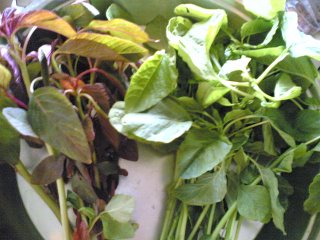“Amaranth, though relatively unknown today, was cultivated as a food crop in Mexico as early as 7000 years ago. Amaranth grain constituted a principal source of protein for the pre-Hispanic populations of Mesoamerica. Along with beans and corn, amaranth was a fundamental part of the indigenous Mexican diet.â€
This was news to me. I thought Amaranth or Thota kura, as its called in our state of Andhra Pradesh, was native to Indian and China. I was wrong. (I must appreciate and thank Kalyn of Kalyns Kitchen for starting a wonderful theme.vIf not for her, I surely wouldnt know so many facts about different herbs and vegetables.
Amaranth has been used for centuries because of its nutritional qualities and today its value has been re-discovered by the health-conscious who have developed a liking to it because of its ability to provide high nutrition both as a vegetable and as a grain. I found some interesting facts on the history of Amaranth here.
Amaranth is herbaceous plant of the genus Amaranthus, is also known as Chinese spinach, choy, tamri bhaji, chauli, thota kura, mullukkirai, Jacob’s coat and Joseph’s coat. The edible tender leaves and stems, rich in vitamins A and C, protein,folic acid, calcium and iron, are considered as vegetable and are cooked like spinach. Iron levels in amaranth leaves are three times more than those of spinach and the leaves have a taste similar to spinach, but are much sweeter. These leaves are low in saturated fat, and very low in cholesterol and also a very good source of Riboflavin, Vitamin B6, Magnesium, Phosphorus, Potassium, Zinc, Copper and Manganese. Amaranth is generally available as a red variety (such as red saag, red spinach or red leaf amaranth) or as green amaranth (such as green pointed leaf,tender leaf or green round leaf). The picture above reflects both the red and green amaranth variety. For more information (with pictures) on different varieties of Amaranth leaves follow this link.
Amaranth is considered to be one of the most nutritious plant in the world.Popped amaranth seeds provide a good source of protein which can satisfy a large portion of the recommended protein requirements for children and can also provide approximately 70% of necessary calories. A combination or rice and amaranth, in a 1:1 ratio, has been designated as an excellent way to achieve the protein allowance recommended by the World Health Organization.
Amaranth is a multi-purpose plant in India. The tender leaves and shoots of the amaranth plant are relished as a green vegetable and are excellent for stir-fries and soups. In some regions of the country,the grains are popped and mixed with milk and sugar to prepare kheer (sweet drink) and without milk to prepare halwa (sweet pudding). The roasted and partially popped grains are milled into flour and used to make rotis (flat Indian bread) or, fried in oil to make puris (puffed Indian bread) or crisp pakoras (fritters).
To prepare any recipe using amaranth, wash the greens thoroughly and slice the older woodier stems and use only the tender stems and leaves, which have a mild spinach flavor,for salads. Stems and leaves that may be more mature can be used in stir-fry dishes, soups and steamed dishes with noodles.
In Andhra ,Thota Kura is used to prepare dal dishes,stir-fries and soups. Today’s recipe is Thota Kura Peasarapappu which is a stir fry lentil dish cooked with amaranth leaves. Very nutritious, tasty and goes well with rice and rasam.





















